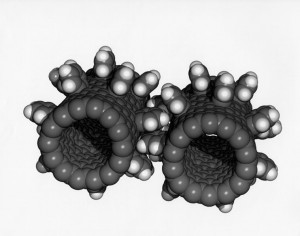SUNDAY, 12 DECEMBER 2010
The group started out with a silver surface. Cobalt atoms and the rod-shaped molecule ‘sexiphenyl-dicarbonitrile’ were then place on the surface and allowed to react with each other. The result is a honeycomb-like structure with a lattice of exemplary regularity and stability that rivals that of graphene. Further molecular building blocks were then added to the system. These gathered in groups of three within the honeycomb structure to form well-ordered triple-blade rotors. The molecules orientated themselves in such a way that the nitrogen ends faced a phenyl-ring hydrogen atom. These interactions are weak compared to those of the honeycomb mesh. As a result, the rotor could be made to rotate, by driving it with thermal energy, without affecting the structural integrity of the system.These self-assembled structures hold enormous potential for studying the interactions of individual molecules within the honeycomb lattice and offer a novel approach to the formation of structures on the nanoscale.
Written by Katherine Thomas

